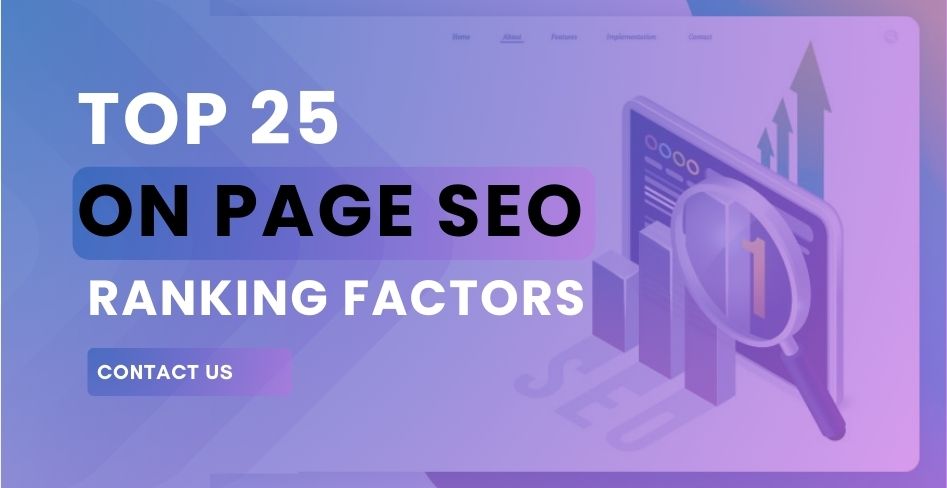Unlocking the Power of On-Page SEO Ranking Factors: A Comprehensive Guide
In the ever-evolving landscape of search engine optimization (SEO), on page SEO factors remain a cornerstone of achieving high rankings in search engine results pages (SERPs). From crafting compelling content to optimizing technical elements, mastering on-page SEO is essential for enhancing your website’s visibility and attracting organic traffic. In this guide, we delve into the fundamental on-page SEO factors and explore actionable strategies to propel your website to the forefront of search engine results.
Understanding On-Page SEO
On-page SEO encompasses a range of practices aimed at optimizing individual web pages to improve their search engine rankings and drive relevant traffic. Unlike off-page SEO, which focuses on external factors like backlinks and social signals, on-page SEO revolves around optimizing elements directly within the website itself. By fine-tuning various on-page elements, you can signal to search engines the relevance, quality, and authority of your content, thus enhancing your chances of ranking prominently for targeted keywords.
Key On Page SEO Ranking Factors
1. High-Quality Content
Compelling, informative, and relevant content lies at the heart of successful on-page SEO. Search engines prioritize content that provides genuine value to users, so aim to create comprehensive, well-researched, and engaging content that addresses the needs and interests of your target audience. Incorporate targeted keywords naturally within your content while maintaining readability and coherence.
2. Keyword Optimization
Strategic keyword optimization is vital for on-page SEO success. Conduct thorough keyword research to identify relevant terms and phrases with adequate search volume and moderate competition. Integrate these keywords strategically into your titles, headings, meta descriptions, and body content to signal the topic and relevance of your page to search engines.
3. Title Tags and Meta Descriptions
Craft compelling title tags and meta descriptions that accurately reflect the content of your web pages while enticing users to click through from the search results. Include primary keywords naturally within these elements to improve their visibility and relevance to search queries. Keep your titles concise (under 60 characters) and meta descriptions informative yet concise (under 160 characters) to optimize for both search engines and user experience.
4. URL Structure
Optimize your URL structure to make it descriptive, user-friendly, and keyword-rich. Clear, concise URLs that include targeted keywords can enhance the visibility and click-through rates of your pages in search results. Avoid lengthy, cryptic URLs with unnecessary parameters or dynamic strings, and utilize hyphens to separate words for improved readability.
5. Header Tags (H1, H2, etc.)
Utilize header tags (H1, H2, H3, etc.) effectively to structure your content and signal its hierarchy to search engines. The H1 tag should typically contain the primary keyword and provide a concise summary of the page’s content, while subsequent header tags can be used to organize subtopics and sections. Incorporating keywords naturally within header tags can help reinforce the relevance and topical focus of your content.
6. Optimized Images and Alt Text
Enhance the SEO value of your web pages by optimizing images with descriptive filenames, relevant alt text, and appropriate captions. Alt text provides textual context to search engines, enabling them to understand the content and purpose of images. Incorporate targeted keywords naturally within alt attributes to improve image search visibility and accessibility for users with disabilities.
7. Internal Linking
Implement a strategic internal linking strategy to connect related pages within your website and distribute link equity effectively. Internal links help search engines discover, crawl, and index your content more efficiently, while also establishing topical relevance and authority across your site. Incorporate descriptive anchor text containing relevant keywords to provide context and guide users to relevant resources or pages.
8. User Experience (UX) Optimization
Prioritize user experience by optimizing page load speed, mobile responsiveness, and overall site performance. Search engines consider factors such as bounce rate, dwell time, and mobile-friendliness when evaluating the quality and relevance of web pages. Ensure intuitive navigation, clear calls-to-action, and a seamless browsing experience to enhance engagement and satisfaction among your site visitors.
9. Schema Markup
Implement structured data markup (schema.org) to provide search engines with additional context and metadata about your content. Schema markup helps search engines understand the meaning and relationships between different elements on your page, which can lead to enhanced visibility in rich snippets, knowledge graphs, and other SERP features. Leverage schema markup to highlight key information such as reviews, ratings, events, and FAQs.
10. Content Freshness and Updates
Regularly update and refresh your content to reflect the latest information, trends, and developments in your industry or niche. Fresh, up-to-date content signals relevance and authority to search engines, potentially leading to higher rankings and increased visibility over time. Monitor performance metrics and user feedback to identify opportunities for optimization and refinement across your website.
Conclusion
Mastering the art of on-page SEO is essential for maximizing your website’s visibility, relevance, and authority in search engine results. By focusing on high-quality content creation, strategic keyword optimization, and meticulous attention to on-page elements, you can elevate your website’s rankings and attract organic traffic from your target audience. Incorporate the aforementioned on-page SEO ranking factors into your optimization efforts, and continually monitor and adapt your strategies to stay ahead in the competitive landscape of search engine optimization.










